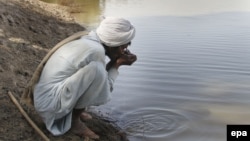When disaster strikes, survivors risk being left without one of life's essentials -- clean, drinkable water.
In the wake of the destruction wrought by the 2004 Indian Ocean tsunami, an interdisciplinary group of researchers from Australia, Malaysia, Singapore, and the United States sought to develop an inexpensive and practical method of water purification.
Their solution? A spongelike gel embedded with silver nanoparticles that can absorb impure water, kill bacteria within seconds, and release drinkable water with just a quick squeeze.
William Krantz, a visiting professor at the Singapore Membrane Technology Center at Nanyang Technological University, contributed to the study, whose results were recently published in the scientific trade journal "Environmental Science & Technology."
"These cryogels not only purify the water in the sense of removing particulates -- and not only make it look good -- but they kill the pathogens," Krantz says. "And they do it very fast."
When tested against Escherichia coli and Bacillus subtilis -- two harmful bacterial strains commonly encountered following natural disasters -- the gel passed with flying colors.
WATCH: This video shows the spongelike gel being squeezed to release purified water. The gel sucks up the water again when the pressure is released.
After 15 seconds in the gel, the amount of bacteria in the treated water was reduced by a factor of between 100,000 and 1 million -- depending on the amount of silver nanoparticles embedded in the cryogel.
And that, Krantz says, is something to drink to.
"In terms of the kind of contaminated water supplies that we encounter in disaster relief operations, it's way more than adequate," he says.
Krantz says just 3 grams of the gel material can absorb and disinfect half a liter of water with one squeeze. And the concentration of silver particles -- long known for their antibacterial properties -- falls well within the limit for safe drinking.
After use, the gel quickly returns to its original form and can be reused effectively at least 20 times.
Dr. Daniela Maria Cirillo, head of the Emerging Bacterial Pathogens Unit at the San Raffaele Scientific Institute in Milan, sees great potential for the gel during disaster-relief operations, such as those happening right now in Russia's Far East, which has been plagued by record flooding.
"The combination of the cryogel with a high porosity, very good mechanical and water-absorption properties, and the capacity to disperse a fine preparation of silver nanoparticles can be a very promising device to provide water purification in [case of] emergency," Cirillo says.
The researchers say personal-sized gel treatments would cost less than $0.50 cents each and that emergency-aid workers could easily deliver them by airdrop in places where contaminated water is found.
Cirillo, however, notes the gel will need to be tested on pathogens in the field to make sure it works in practice.
Krantz says the research team is currently eyeing Burma (also known as Myanmar), Indonesia, and Thailand as possible countries where the method can be field-tested.
In the wake of the destruction wrought by the 2004 Indian Ocean tsunami, an interdisciplinary group of researchers from Australia, Malaysia, Singapore, and the United States sought to develop an inexpensive and practical method of water purification.
Their solution? A spongelike gel embedded with silver nanoparticles that can absorb impure water, kill bacteria within seconds, and release drinkable water with just a quick squeeze.
William Krantz, a visiting professor at the Singapore Membrane Technology Center at Nanyang Technological University, contributed to the study, whose results were recently published in the scientific trade journal "Environmental Science & Technology."
"These cryogels not only purify the water in the sense of removing particulates -- and not only make it look good -- but they kill the pathogens," Krantz says. "And they do it very fast."
When tested against Escherichia coli and Bacillus subtilis -- two harmful bacterial strains commonly encountered following natural disasters -- the gel passed with flying colors.
WATCH: This video shows the spongelike gel being squeezed to release purified water. The gel sucks up the water again when the pressure is released.
After 15 seconds in the gel, the amount of bacteria in the treated water was reduced by a factor of between 100,000 and 1 million -- depending on the amount of silver nanoparticles embedded in the cryogel.
And that, Krantz says, is something to drink to.
"In terms of the kind of contaminated water supplies that we encounter in disaster relief operations, it's way more than adequate," he says.
Krantz says just 3 grams of the gel material can absorb and disinfect half a liter of water with one squeeze. And the concentration of silver particles -- long known for their antibacterial properties -- falls well within the limit for safe drinking.
After use, the gel quickly returns to its original form and can be reused effectively at least 20 times.
Dr. Daniela Maria Cirillo, head of the Emerging Bacterial Pathogens Unit at the San Raffaele Scientific Institute in Milan, sees great potential for the gel during disaster-relief operations, such as those happening right now in Russia's Far East, which has been plagued by record flooding.
READ NEXT: Computer Exposure Leads To Fears Of 'Digital Dementia'
"The combination of the cryogel with a high porosity, very good mechanical and water-absorption properties, and the capacity to disperse a fine preparation of silver nanoparticles can be a very promising device to provide water purification in [case of] emergency," Cirillo says.
The researchers say personal-sized gel treatments would cost less than $0.50 cents each and that emergency-aid workers could easily deliver them by airdrop in places where contaminated water is found.
Cirillo, however, notes the gel will need to be tested on pathogens in the field to make sure it works in practice.
Krantz says the research team is currently eyeing Burma (also known as Myanmar), Indonesia, and Thailand as possible countries where the method can be field-tested.













